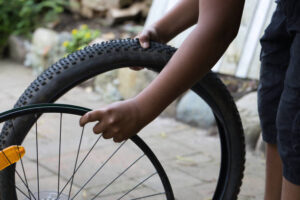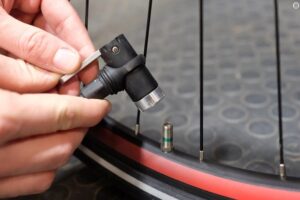How To Fix A Flat Tire On A Bicycle

How to fix a flat tire on a bicycle – A flat tire is an inconvenience every cyclist may encounter at some point. However, knowing how to fix a flat tire is an essential skill that can save you time and frustration during your cycling adventures. Changing a bike tire after a flat is a very simple fix—as long as you know what you’re doing. Whether you ride on smooth pavement, bumpy gravel, or rocky single-track trails, it’s likely to happen someday, so arm yourself with the required tools and bike repair skills to deal with the issue.

In this article, we will provide you with a step-by-step guide to help you get back on the road quickly and confidently.
Read Also: 10 Ways to Get Rid of Mucus in Your Chest
Materials Needed:
- Bicycle tire levers (usually come in sets of two or three)
- Replacement inner tube (correct size for your tire)
- Bike pump or CO2 inflator
- Patch kit (optional, for repairing tubes)
- Water or soapy solution (for locating punctures)
A Step-by-Step Guide to Fixing a Flat Tire on a Bicycle
Step 1: Find a Safe Spot
If possible, move to a safe location away from traffic to avoid any accidents while fixing your flat tire. Find a level surface to work on, such as a sidewalk or bike path.
Step 2: Remove the Wheel
Shift your bike to the highest gear to alleviate tension on the chain. Open the quick-release lever or use a wrench to loosen the nuts securing the wheel axle. Once loose, carefully lift the wheel off the bike frame, being mindful of the chain and brake cables.
Step 3: Deflate the Tire
Using your thumb or a valve cap, press the valve stem of the inner tube to release any remaining air. If necessary, push down on the tire with your palms to expel the air more quickly. Once deflated, use the tire lever to pop one side of the tire bead over the rim, exposing the inner tube.

Step 4: Remove the Inner Tube
Starting opposite the valve, slide one tire lever under the bead and hook it onto a spoke. With another lever, repeat the process a few inches away. Gently pry the tire lever upward, lifting the bead over the rim, until you can easily pull the rest of the bead off by hand. Carefully remove the inner tube from the tire.
Step 5: Inspect and Locate the Puncture
Inflate the inner tube slightly to help you identify the puncture. Submerge it in water or apply a soapy solution along its surface. Look for air bubbles indicating the location of the leak. Once located, mark the puncture with a pen or remember its position for repair or replacement.
Read Also: 15 Morning Habits for a Productive Day (Start Today Right)
Step 6: Repair or Replace the Inner Tube
If you have a patch kit and the puncture is small, follow the instructions provided to patch the hole. Alternatively, if the puncture is too large or the tube is extensively damaged, replace it with a new one of the appropriate size. Starting at the valve, insert the new or patched tube into the tire, tucking it neatly within the tire casing.
Step 7: Reinstall the Tire
Begin by pushing the valve stem through the valve hole in the rim. Working your way around the wheel, carefully tuck the inner tube inside the tire, ensuring it is not pinched or twisted. Use your hands to press the tire bead back onto the rim. If necessary, employ the tire levers to assist, but be cautious not to pinch or damage the tube.
Step 8: Inflate the Tire
Using a bike pump or CO2 inflator, inflate the tire to the recommended pressure stated on the sidewall of the tire. Take care not to overinflate. Check that the tire is evenly seated on the rim and there are no bulges or misalignments.
Step 9: Reattach the Wheel
Place the wheel back into the bike frame, aligning the chain on the correct gear. Tighten the quick-release lever or nuts on the axle securely. Ensure the wheel is centered and spins freely without any rubbing against the brake calipers or frame.enoughinfo.com
Step 10: Test and Adjust
Give the tire a gentle squeeze to check if it feels firm and properly inflated. Spin the wheel to ensure it rotates smoothly and does not wobble. Double-check the brakes to make sure they are functioning correctly. Take a short test ride to ensure the tire is stable and there are no unusual vibrations or issues.
Read Also: SpaceX Starship, World’s Biggest Rocket, Ready For First Test Flight
How to plug a tubeless tire
For tubeless systems, which are becoming increasingly popular on gravel, cyclocross, and even certain road bikes, your sealant should do the job without you ever realizing it. Check your sealant on a regular basis (every three to six months) to ensure that the tire has enough and that it hasn’t dried out.
However, a tire plug may be required to stop air loss in the event of a larger puncture or side-wall rupture. Plug kits include a thin piece of rubber and an insertion device, allowing you to plug the hole without having to remove the wheel. After you’ve located the puncture and inserted the rubber plug, re-inflate your tire to the proper pressure to ensure it’s retaining air. If this is the case, restart riding and periodically inspect the repair to ensure it is secure. You could potentially add more sealant, but you’d need a valve core removal tool and a small quantity of sealant with you.
If the air loss is caused by a larger puncture than a plug repair, you could attempt a patch or a boot on the tire. But be warned: Without completely cleaning the area, it will be impossible to get a patch to adhere to your sealant-coated tire. Adding more sealant or a patch may cause another issue by allowing all of the air to escape and breaking the seal between the rim and tire. It’s unlikely that you’ll be able to reseat the tire bead onto the rim on the spot. The simplest solution to ensure your tire retains air at this stage is to simply ride with a spare emergency tube and handle the problem later at home or at a bike shop.
FAQs & Answers
1, How can I prevent flat tires while cycling?
While flat tires are inevitable at times, there are measures you can take to reduce their occurrence. Firstly, regularly check your tire pressure and ensure it is within the recommended range. Avoid riding over sharp objects and debris on the road whenever possible. Additionally, consider using puncture-resistant tires or tire liners, which provide added protection against punctures.
How do I know when it’s time to replace my bicycle’s inner tube? Inner tubes can wear out over time or become damaged beyond repair. Signs that indicate the need for replacement include repeated flats in the same area, visible cracks or holes, or a worn-out valve. If you are uncertain, inflate the tube separately and check for any air leaks or signs of weakness.
2, Can I patch a tube multiple times?
It is generally recommended to limit patching a tube to a maximum of two or three times. Each time you patch a tube, its integrity may become compromised, increasing the risk of additional punctures or leaks. Eventually, it’s best to replace the tube to ensure a reliable and safe ride.
3, Should I carry a spare tube or a patch kit?
It is advisable to carry both a spare tube and a patch kit during your rides. In the event of a small puncture, a patch kit allows you to repair the tube on the spot. However, if the damage is extensive or you encounter multiple flats, having a spare tube ensures a quicker and more convenient solution.
Read Also: How To Make The Best Out Of Binaural Beats
4, How do I properly inflate my bicycle tire?
Inflate your bicycle tire to the recommended pressure indicated on the sidewall of the tire. Use a reliable bike pump with a pressure gauge or a CO2 inflator. Inflate the tire gradually, periodically checking the pressure with a gauge until it reaches the desired level. Avoid overinflating, as it can lead to tire damage or an uncomfortable ride.
5, Can I use an electric pump or a gas station air pump to inflate my bike tire?
While it’s possible to use an electric pump or a gas station air pump, it’s important to exercise caution. These pumps can deliver high pressure quickly, which may cause the tube to overinflate and potentially burst. If using such pumps, inflate the tire in short bursts and check the pressure frequently to prevent overinflation.
6, How often should I check my tire pressure?
It is recommended to check your tire pressure before every ride or at least once a week. Proper tire pressure ensures optimal performance, and grip, and reduces the risk of flats. Factors such as temperature, riding conditions, and the type of tire can affect the pressure, so regular checks are essential. How to fix a flat tire on a bicycle
7, Is it necessary to remove the wheel from the bicycle to fix a flat tire?
Yes, it is necessary to remove the wheel from the bicycle to fix a flat tire. Removing the wheel allows easier access to the inner tube, making it simpler to replace or repair. Additionally, it prevents any potential damage to other components of the bike while working on the tire.
8, Can I fix a flat tire on a tubeless bicycle tire in the same way?
Tubeless bicycle tires require a slightly different approach to fixing flats. Instead of using an inner tube, tubeless tires rely on a sealant to seal punctures. For small punctures, the sealant can often seal the hole automatically. In the case of larger punctures, a plug or patch specifically designed for tubeless tires may be necessary. Consult your bicycle manufacturer’s guidelines for the proper procedure for fixing flats on tubeless tires.
Read Also: How to Lose Face Fat (11 Natural and Stress-free Methods)
Conclusion:
Knowing how to fix a flat tire is an invaluable skill for any cyclist. With a few simple tools and some basic know-how, you can easily get back on the road without relying on external assistance. Remember to always carry a spare inner tube, patch kit, and tire levers with you during your rides.
By following this step-by-step guide, you’ll be well-prepared to handle a flat tire on your bicycle. Stay safe, be prepared, and enjoy your cycling adventures with the confidence that you can tackle any flat tire situation that comes your way.
